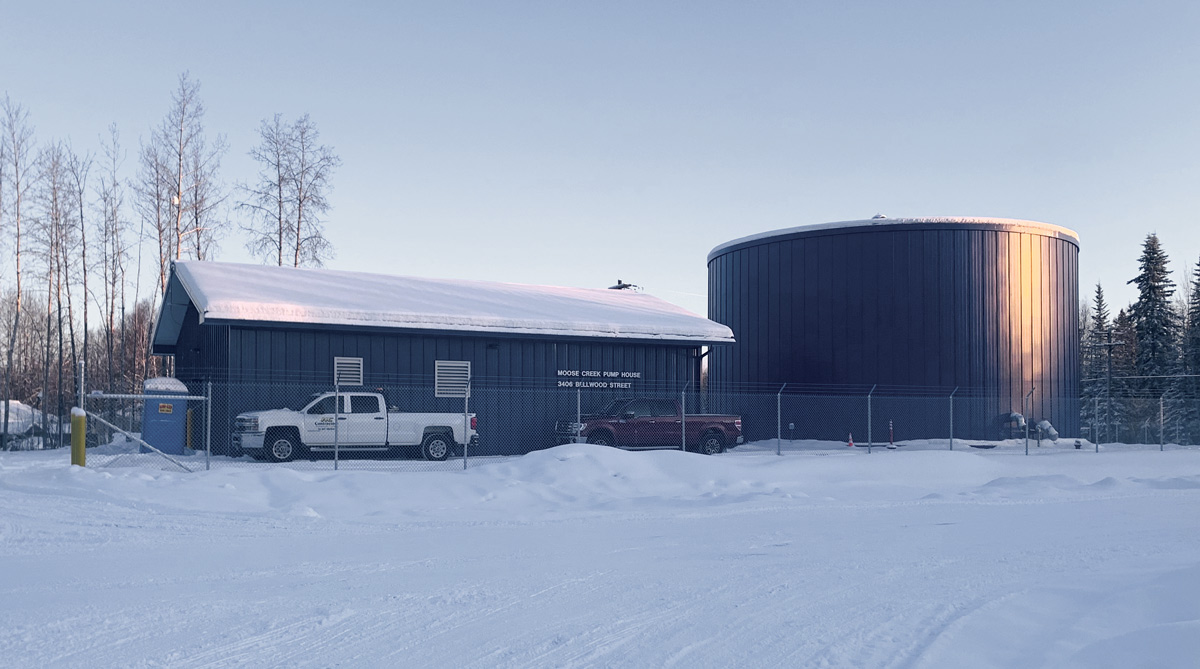to Connect
Photo courtesy of HC Contractors
Photo courtesy of HC Contractors
y the end of summer, North Pole Utility will be the permanent water source for the nearby community of Moose Creek. The two-year project is ahead of schedule, after a productive 2020 summer and fall, in which construction crews completed a chunk of work initially slated for spring 2021. When completed, the Moose Creek Water System Expansion Project will provide potable water to more than 200 properties affected by perfluorinated-chemicals, or PFCs, in the groundwater.
HC Contractor Project Manager Jordann Conlon says the project has gone smoothly despite the pandemic and unexpected environmental challenges that arose last year.
“We were fortunate that our vendors got materials to us on time, and we were able to bring more crews to work on the project,” she says.
Photo courtesy of HC Contractors

Photo courtesy of HC Contractors
“I think the Air Force decided they didn’t want to get in the water utility business,” says Karen Brady, utility sector director for PDC Engineers.
Brady says the actual design wasn’t as challenging as determining a feasible route and pulling together all the necessary paperwork within a short amount of time. The early plan was to have the transmission main follow the Richardson Highway. However, the bridge over the Chena River Flood Control Project couldn’t support it. Another alternative was to bury the transmission main immediately south of the bridge, but potential high flow in the flood control channel could expose and damage the water main. Eventually, engineers determined the best route lay north of the bridge, over the flood control dike.
The various landowners and agencies involved required extensive permits and meetings before the team could finalize an optimum design.
“In addition to the floodplain, this project runs along borough roads, state highways, and crosses the railroad. We had a lot of agencies to coordinate with to meet criteria and schedule construction,” says Brady.
There is a single six-mile water transmission main connecting the city’s water system with the pump house in Moose Creek. Water is pumped back-and-forth between the city and Moose Creek to provide freeze protection for the transmission main. Within Moose Creek, there are two distribution loops fed with water from the Moose Creek Pump House. The northern loop will serve most properties north of the Old Richardson Highway, and the southern loop will serve properties south of the highway. A pump house located at the intersection of Pam Avenue and Bellwood Street will heat the water as necessary to prevent the water mains from freezing, and the 410,000-gallon tank adjacent to the pump house will provide two days’ supply of water in case emergency repairs to the transmission main are needed.
Photo courtesy of HC Contractors

Photo courtesy of HC Contractors
Conlon says she feels they did a good job minimizing the environmental impact on the Chena floodplain, especially at the stream crossing at the bluff.
“We have been really happy with the progression of this project,” says Conlon. “The designers have been onsite full-time, which has proven helpful when challenges do arise.”
The only issue to interrupt the project was a higher than expected water table along the flood channel. Brady says crews found themselves working in two to five feet of water at the worst time possible: they needed to dewater the area before digging a trench for the piping. Conlon says dewatering didn’t become complicated until they reached the area in Moose Creek that was contaminated with Perfluorooctanesulfonic acid, or PFOS.
“At that point, you have to be careful not to spread contaminants during the dewatering process,” Conlon says. “We have a very strict set of rules while working in PFOS conditions.”
Bill Butler, North Pole director of city services, clarifies in a North Pole Utility newsletter that the new system does not include fire protection. Widely-spaced fire hydrants have been installed in the area, but their only function is to flush the mains, collect water samples, and accommodate maintenance work.
“The USAF can only provide for what was lost—access to drinking water,” Butler writes in the newsletter.
Within Moose Creek, the project will provide up to 220 water service connections to homes and businesses. Once connections are made and wells decommissioned, HC Contractors will finish site cleanup and hand the system over to the City of North Pole.